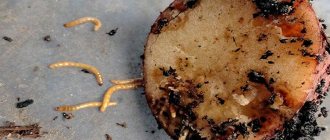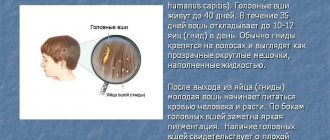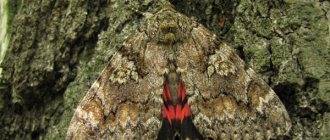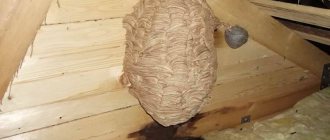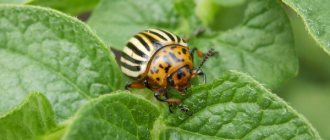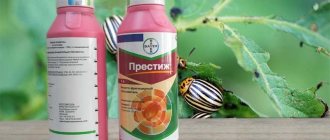- What kind of scab is there?
- Why does scab appear?
- Varieties resistant to scab
- How to treat scab?
- Traditional methods of treatment
- Preventive actions
Scab is a fungal infection of potatoes. The harmfulness of scab is significant, but this disease does not cause the death of the plant as such. Typically, the period of scab activity occurs during the formation of potato tubers and this activity continues throughout the entire growing season of the plant. Tubers are affected by scab; you can tell that they are infected with scab by small brownish spots on their surface, which, growing, lead to the appearance of noticeable growths and even ulcers on the surface of the tubers.
If the scab is rampant, then the tubers can be completely covered with crust and become completely unattractive and unmarketable. Typically, such potatoes are considered defective; they try not to store them at all, because during storage, after a short time, dry and gray rot appear on the surface of the tubers.
If the tubers are slightly affected by scab, then they can be stored for a short time - I advise no more than a month, eaten or fed to animals.
What kind of scab is there?
Common scab is the most common. Its signs are small ulcers that can be concave, convex, flat or covered with a mesh. Often, ordinary scab affects not only the skin of tubers, but also the deeper tissues of the pulp, as well as roots and stolons.
Often the convex shape of common scab resembles warts. With a concave shape, the bottom of the spots is literally pressed into the tuber, while the edges are raised. With a flat form, scab can affect the skin or surface of often the youngest tubers. In this case, rusty-brown ulcers are clearly visible. With reticulated scab, you can see depressions intersecting at sharp angles and forming a kind of mesh.
Silvery scab - with it, darkish-grayish spots are formed on the surface of the tubers, having a shine and coating, which can be easily erased with a little effort. Often, such tubers are placed for storage, since they believe that the damage is not serious, but during storage, the skin of the tubers begins to peel off, moisture gets into the peeled parts of the skin and this place acquires a silvery tint, hence the name scab.
Lumpy scab - usually this type of scab manifests itself already during storage and not immediately, but after 3 or more months of storing tubers. Tubers affected by tuberous scab are covered with small tubercles. If there are a lot of tubercles, then they stick together or grow together in groups of 4-5 pieces. At the same time, the skin of the tubers begins to peel off and becomes wrinkled. It is interesting that during storage not only lumpy scab manifests itself, but also silvery scab.
Black scab - it can manifest itself both on tubers and on the roots and even stems of potato plants. You can see black growths on the tubers, which, however, can be easily scraped off. Some gardeners don’t even pay attention to them, often mistaking them for parts of soil stuck to the tubers, but later wet spots appear in this place. Often the sprouts of such tubers die when planted.
With black scab, ulcers and brownish spots may appear on the stems and root system of potato plants.
Powdery scab - often when potato plants are affected by powdery scab, very large, light-colored warts can be seen on the tubers, which are literally filled with a gel-like composition. Essentially, these are fungal spores; when such ulcers are destroyed, they flow onto healthy tubers, affecting them too. Subsequently, slightly deepened ulcers with jagged edges form in the place where the warts were.
If the powdery scab is severely affected, the roots, stolons and stems of the potato plants themselves may also be damaged; growths form on them, darkening over time.
Causes of scab on potatoes
Scab on potatoes photo
- The pathogen lives in the soil on organic residues and, under favorable conditions, switches to feeding on the underground organs of potatoes.
- Scab lives with active access to oxygen. A decrease in air content in the soil leads to suppression of the viability of actinomycetes. Often the damage to tubers depends on the depth of their occurrence in the soil. In deeper layers, where there is less air, scab develops less easily.
- Plant debris that has not decomposed and fresh organic fertilizers contribute to the development of the disease. To speed up the decomposition of plant residues, it is better to introduce biological stubble decomposers - preferably with the drug Trichodermin.
- The vital activity of pathogenic species and strains of actinomycetes is activated in the presence of free calcium and nitrites in the soil.
- The high content of organic matter in the soil, mainly in the form of humus, suppresses the pathogens of common scab.
- When the tuber reaches a size of 1 - 2 cm in diameter, the scab fungus cannot infect the plant, since a cork layer has already formed. A particularly dangerous period of potato damage is the youngest age and the formation of tubers when the potato has not yet created a protective layer on the root crops.
- It has been noted that on slightly acidic soils, scab on potatoes almost never occurs. You should not plant potatoes in fields where lime has been applied for at least two to three years. Additionally, you should not use fertilizers with an alkaline reaction. It is better to apply neutral, acidic or slightly acidic fertilizers.
Varieties resistant to scab
There are quite a lot of such varieties, let’s name the most interesting:
- Zhukovsky early is an early variety that is resistant to lack of moisture in the soil. Produces pinkish-colored tubers that taste great.
- White Spring is also a variety that produces crops early. Produces white tubers that store well.
- Lugovskoy - yields crops early, is incredibly unpretentious in cultivation, tubers are perfectly stored, and the harvest is excellent.
- Elizaveta is a variety quite familiar to many; it produces white tubers and excellent taste. The variety is suitable for cultivation in Central Russia, the North-West of the country, the North Caucasus and even the Far East.
- Tempo - characterized by high yields, yields the harvest at a later date, forms tubers that are distinguished by creamy pulp and are suitable for all types of processing and for long-term storage.
Types of scab on potatoes
Photos of varieties of scab on potatoes
Scab on potatoes spoils the appearance of tubers, impairs their keeping quality, planting qualities, reduces yield, etc. The main symptoms are rough, flaky spots on the tubers that appear in the summer.
There are four types of common scab: flat, raised, deep and reticulate.
- Flat scab occurs mainly on young tubers and is characterized by damage to only the superficial layer of the periderm. Rusty-brown, scab-like ulcers form on the tubers.
- Raised scab on potatoes looks like raised scabs or warts.
- Deep scab forms ulcers pressed into the pulp (up to 0.5 cm), the edges of which are often raised, the bottom is reddish or purple. This type of scab is typically seen when potatoes are harvested.
- Net scab on potatoes is characterized by continuous cracking of the surface of the tuber in the form of shallow grooves that intersect each other in different directions and resemble a net.
Preventive measures to combat scab
The main way to combat this disease is to comply with crop rotation requirements. If potatoes are planted on a plot no more than once every 4-5 seasons, then during this time the scab spores die. But some other vegetable plants cannot be planted in such beds - tomatoes, bell peppers, eggplants, as well as carrots and beets, since these vegetables also have poor resistance to scab.
And few vegetable growers have plots that are too large to change the location for planting potatoes. Experts recommend immediately after harvesting potatoes to sow the area with the following green manures: mustard, legumes or cereals.
When the green manure reaches a height of 12-14 cm, the ground is dug up, embedding the plants in the soil. When they rot, saprophytic fungi and bacteria are formed, which are enemies of scab pathogens and contribute to their destruction. This method of fighting scab was used many decades ago, and it was very effective.
In the spring, you can repeat planting green manure, or sprinkle the beds in which you plan to plant potatoes with mustard powder and pour plenty of water.
When adding fertilizer to the soil before planting, you should not use fresh manure - it can provoke a scab outbreak.
The spores of this disease develop better in alkaline soils with a small amount of manganese and boron, so in the spring it is recommended to apply the following fertilizers (per 100 m2) to the beds:
- ammonium sulfate – 1500 g;
- superphosphate – 2000 g;
- calomagnesia – 2500-3000 g;
- copper sulfate – 2 tbsp. l., manganese sulfate 1 tbsp. l., boric acid - 1 tbsp. l.
Additional Information
Two simple methods for determining soil acidity
- Vinegar test. Pour ordinary table vinegar onto a handful of soil from the desired field. If the soil contains optimal or increased lime content (neutral and alkaline soil, respectively), then acetic acid will react and, after mixing with the soil, begin to release carbon dioxide, appearing in the form of foam and “boiling.” If there is not enough lime (acidic soil), then the reaction will not occur.
- Checking with a currant gull. You should take 3-4 blackcurrant leaves, pour a glass of boiling water over them and leave until the water reaches room temperature. Add soil from the field you want to check into the container with the infusion. The water will change color, by which you can determine the acidity of the added soil: red - pH 3.5-4.5; pink - pH 4.5-6.5; green - pH about 7; blue - pH 7 and higher.
How to treat scab?
Agat-25 is a growth regulator, a relatively harmless drug. You can treat seed potatoes with it before planting, you can also spray bushes with it during the season, this is especially important at the stage of plant closure. For example, let’s say if you want to treat 100 kg of tubers with this drug, then you need to dilute 14 g of the drug in 500 ml of water. If you want to treat 10 m2 of area, then you need to dilute 1 g of the drug in a bucket of water (10 l).
Fitosporin-M is another fairly harmless drug. It can be used to treat potato tubers before planting; for 40 kg of tubers you need about 20 g of the drug diluted in 5 liters of water. Plants can also be watered with the drug 3 times per season, divided into equal periods. For 10 m2 you need to dilute 2 g of the drug in a bucket of water (10 l).
Maxim, a more serious and effective drug, which it is advisable to use for the first time when treating seed potatoes before storing them, in the amount of 2 ml of the drug per 500 ml of water, this is the norm for 10 kg of seed potatoes, which are not used for food in the spring, before planting potatoes in the amount of 4 ml per 500 ml of water - the norm for the same volume of potatoes. In the fall, be sure to dry the tubers after processing; in the spring, you don’t have to dry them, just process them and plant them immediately.
Quadris is a fungicide; it can be used to treat the holes in which you are going to plant potatoes. The drug is diluted in an amount of 3 ml per bucket of water. Just one liter is enough to treat the soil in 100 holes. Interestingly, the drug protects potatoes for 3 months.
Prestige KS - tubers are treated with this drug before germination begins. Per liter of water you need approximately 50 ml of the drug, this amount is enough for 50 kg of tubers.
Traditional methods of treatment
Before planting, seed tubers can be treated with a mixture consisting of 6 parts compost, 2 parts infusion of pine needles (infuse pine needles for a day) and 2 parts infusion of sawdust (infuse sawdust for a day).
Seed potatoes can be treated with boric acid before germination; you need to make a 1.5% solution of boric acid and treat the tubers with it.
Mustard disinfects the soil quite well; after digging up the potatoes, it must be sown on the site, and after a month it must be incorporated into the soil by digging.
When planting potatoes, it is advisable to sprinkle a teaspoon of mustard powder into the holes.
Why do potatoes get scabby?
Scab pathogens (microscopic fungi) are traditional microflora inhabiting the territory of any climatic zone. They grow and develop quite widely and are companions of vegetable growing at almost all stages. It is impossible to get rid of these creatures; they are quite resistant to sudden changes in temperature and humidity, as well as all kinds of chemicals.
In addition, their spores can be stored for a long time outside the soil, so scab can appear even in a conditionally sterile environment. In most cases, plants manage to resist infection, and scab, while maintaining its population, only leads to spot lesions of the bushes. This course of action suits most farmers, but scab often develops uncontrollably on plantings, rendering potatoes completely unusable.
Important! If potato tubers are partially infected, they can be eaten. However, to do this, the affected part and putrefactive lesions should be carefully trimmed.
The main factors that radically influence the activity of infection are considered to be temperature and humidity. They create a special soil microclimate, thanks to which the fungus can grow and develop unhindered. As is known, massive outbreaks of the disease are observed in regions with a mild, warm, moderately humid climate, with an average daily temperature in summer of +20...+30°C.
In addition, it is worth noting that fungal spores successfully reproduce only in light and loose soil, so plantings in areas with sandy loam and sandy soils are most prone to the appearance of fungus. It is also worth noting that the fungus can enter the area due to manure. Many farmers often use poor-quality crops to feed their livestock, but most are unaware that the resulting manure is dangerous for potatoes. It contains a huge amount of fungal spores, which, if released into a favorable environment, will certainly lead to damage to the plantings.
You will be interested to know how to choose green manure for potatoes.
Biology
The causative agent of silver scab spreads through conidia and penetrates the tuber through the lentils. It develops during storage and affects only tubers. At the same time, there is no direct connection between the size of the tuber lesion and the infection of the crop.
The opposite pattern is observed. When planting tubers with a weak degree of infestation, the new crop becomes more infected than when planting seeds with a high degree of infestation. This is explained by the fact that the mycelium on tubers with a strong degree of infection is weakened and the spores formed on it are characterized by low infectivity.
Development conditions
Silver scab often develops on light soils during the tuberization period at elevated temperatures. During storage, the intensive development of the disease is favored by the combination of high humidity and elevated temperature. At +15°C, sporulation is observed after an hour, at +10°C and +5°C, after 2–3 hours. In the presence of water condensate, spores form a new focus of infection within 2–6 hours, ensuring the spread of the pathogen. At a temperature of +3°C, the spread and development of the disease stops.
The disease actively develops during the period of tuber formation on light soils, with rising temperatures.
Sources of infection
Prevention of infection
Potato disease is easier to prevent than to treat. Preventive measures are:
- Treatment of tubers before planting. You must first sort the potatoes and throw away all affected tubers. The remaining potatoes are treated with chemicals that can be purchased at any gardening store.
- Preparation of the garden consists of acidifying alkaline soils, annually changing the location of planting potatoes, and not applying fresh manure before planting.
Drugs for fighting
The most effective way to reduce the likelihood of the disease spreading is considered to be pre-planting treatment of tubers.
Among the biological drugs effective in the fight against rhizoctoniasis are:
The listed preparations are considered environmentally friendly and are approved for use in household plots. But, unfortunately, they do not always cope with their task 100%.
Chemical preparations are more effective (Vivatax 200, Fenoram, Utan, Maxim, Celeste Top, TMTD). But officially only Maxim, Celeste Top and TMTD are allowed to be used in garden plots.
When choosing a TMTD, you need to be prepared for the fact that in a couple of years it will become ineffective. Since it was noticed that when using it, strains resistant to the drug appear.
Celeste Top simultaneously fights all potato diseases and protects against insects. The popular drug Prestige is also effective.
Maxim or Celeste Top is diluted with water according to the instructions and the tubers laid in one row are sprayed so that they become evenly moistened. Consumption of the drug is 0.5-0.7 ml per 1 kg.
To “neutralize” the mycelium in the soil, they are treated with the fungicide Quadris, using 30 ml per 1 sq.m.
Where does the disease come from and how does it develop?
Scab is a disease caused by a fungus.
Reasons for appearance:
- Damaged land.
- Diseased tubers on which the disease is not visible, but the fungus is present, since during the initial spread it is not visible.
- An excess of nitrogen in the soil stimulates the development of scab.
- If you plant potatoes in one place from year to year, diseases will accumulate in the ground.
- High ground temperature.
- Land that has acidic properties.
- Fertilizing the soil before planting potatoes with fresh manure .
Black potato scab
The causative agent of black potato scab is the fungus Rhizoctonia solani, which is activated at temperatures from 16°C to 18°C. He prefers high humidity, which is about 80-100%. The fungus develops in loamy soil.
Signs
The main signs of damage to a vegetable crop by the black variety are black or dark brown spots of damage that appear on the surface of root crops. Over time, they merge into extensive foci. Often, inexperienced gardeners mistake the black form of a fungal disease for soil dirt. Infected seedlings develop with curled leaves.
Spreading
The disease can destroy the entire crop
Black potato scab, or rhizoctonia, is the most dangerous form, affecting the entire potato plant. The black variety of the fungal disease affects potato tubers, stems and foliage. The fungus develops with rapid intensity and is able to penetrate inside the potato tuber already at the germination stage, dooming the future crop to death.
Among the factors contributing to the spread of the disease is a cold rainy period in late spring.
Treatment and prevention
No varieties have been developed that are resistant to the black variety. Given the serious damage caused by this fungal disease, chemicals are often used to combat it. As a preventative measure, gardeners use treatment of tubers with Integral, Vitavax or Baktofit. As an agrotechnical measure, it is recommended to plant vegetables to a depth of no more than 7 cm in sandy loam soil, no deeper than 12 cm in peat and no more than 11 cm in loamy soil. A preventive measure would be to plant in soil heated to at least 8°C. Organic fertilizers and quantities exceeding the usual norm help prevent the black variety of the disease. Reviews from gardeners recommend using copper sulfate to combat the black variety of fungal disease, which needs to be sprayed on the bushes.
Potato rhizoctonia: signs of the disease
Mycelium of the disease on the tops
- Black spots similar to growths appear on potato tubers. This is the mycelium, which has turned into sclerotia, sitting rather precariously on the tubers, and during digging, partly, along with the ground, falls back into the soil.
- When favorable conditions for further development are created (high humidity, low temperature), sclerotia weave thin threads around the tuber, thus approaching the young shoots. Fungal hyphae, entering the epidermis, infect its cells, which form dark spots on the sprouts.
- Infected sprouts die, and secondary buds sprout, which are also affected by the fungus. Stems grown from diseased shoots begin to branch, which is a sign that the main stem is infected. Such damage occurs even at the stage of seed storage. If storage conditions are violated, then rhizoctinia takes root in the developing eyes and the sprouts die before they have time to “hatch” to the surface.
- Affected potato bushes do not develop, remaining stunted.
- When the root becomes diseased, the plant ceases to receive not only the necessary nutrients, but also the water necessary to maintain the turgor of the tissues and organs of the plant. This, in turn, affects the tubers; they become covered with peculiar ulcers, infecting the potatoes from the inside and outside.
- In an infected plant, the stem takes on the appearance of a “white leg”; this is a coating similar to a cobweb, “sitting” tightly at the bottom of the above-ground portion of the stem. The upper leaves curl and rarely acquire an anthocyanin color. This stage of the disease is called basidal. During rain, the plaque is washed away by water underground and infects new, young tubers, but on which black spots of varying sizes appear - these are sclerotia.
